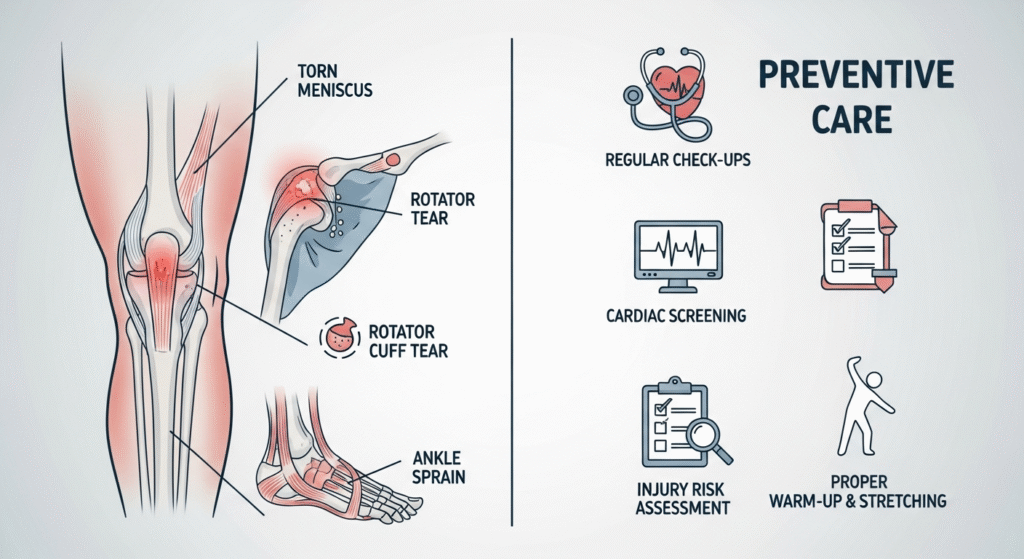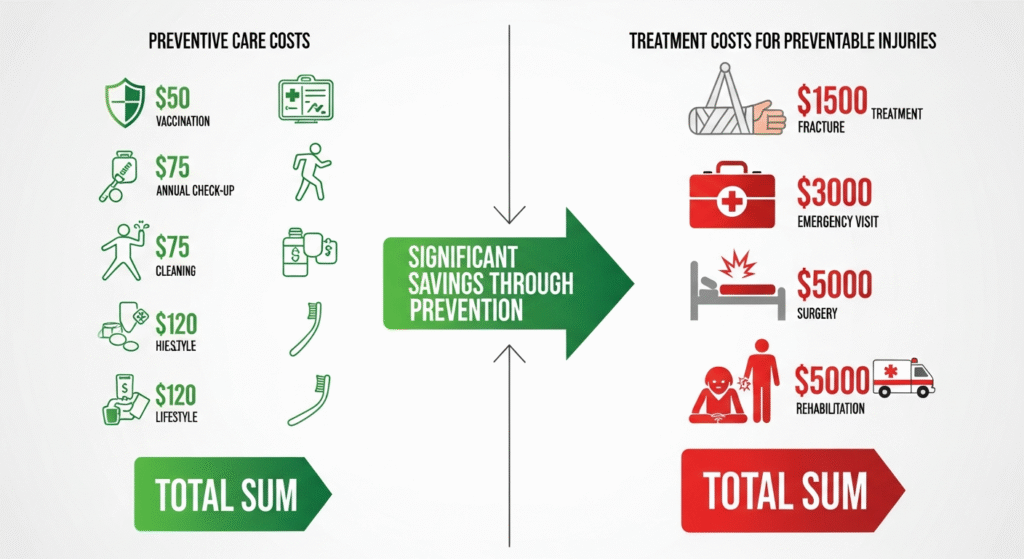Preventive Health Insurance
Athletes are often perceived as the healthiest people in any room. With their disciplined training routines, carefully planned nutrition, and peak physical condition, it’s easy to assume they’re immune to health problems. However, the reality is quite different. Athletes face unique health risks that make preventive health insurance not just beneficial, but essential.
Whether you’re a professional competitor, weekend warrior, or dedicated fitness enthusiast, understanding the importance of preventive health insurance can mean the difference between a long, successful athletic career and one cut short by preventable injuries or undiagnosed conditions.
In this comprehensive guide, we’ll explore why preventive health insurance is crucial for athletes, what coverage you need, and how investing in prevention today can save you from costly problems tomorrow.
What Is Preventive Health Insurance?
Preventive health insurance refers to coverage that focuses on preventing illnesses and injuries before they become serious problems. Rather than only paying for treatment after you’re sick or injured, preventive coverage includes services designed to catch issues early or stop them from developing at all.
Thanks to the Affordable Care Act (ACA), most health insurance plans in the United States must cover certain preventive services at no cost to you—meaning no copayment or deductible when you use an in-network provider.
Common preventive services include:
- Annual physical examinations
- Health screenings (cholesterol, blood pressure, diabetes)
- Immunizations and vaccinations
- Cancer screenings (based on age and risk factors)
- Cardiovascular disease screenings
- Mental health screenings
- Nutritional counseling
- Well-woman visits and reproductive health services
For athletes, preventive insurance goes beyond these basics to include sports-specific assessments, injury prevention programs, and performance optimization services that keep you competing at your best.
Why Athletes Face Unique Health Risks
The athletic lifestyle, while incredibly beneficial, comes with specific health challenges that sedentary individuals rarely encounter. Understanding these risks highlights why comprehensive preventive coverage is so important.
1. Overuse Injuries
Unlike acute injuries from accidents, overuse injuries develop gradually from repetitive stress on muscles, tendons, and bones. Common examples include:
- Stress fractures in runners
- Rotator cuff injuries in swimmers and baseball players
- Tennis elbow in racquet sports athletes
- Patellar tendinitis in basketball and volleyball players
- Achilles tendinopathy in track athletes
These injuries can sideline you for months if not caught early. Preventive care includes biomechanical assessments, gait analysis, and regular monitoring that can identify problems before they become debilitating.
2. Cardiovascular Concerns
Intense training puts significant stress on your cardiovascular system. While exercise strengthens the heart, certain conditions can make vigorous activity dangerous:
- Hypertrophic cardiomyopathy (leading cause of sudden cardiac death in young athletes)
- Coronary artery disease (even in younger athletes)
- Arrhythmias triggered by intense exercise
- Exercise-induced hypertension
Preventive cardiovascular screenings can identify these conditions before a potentially fatal cardiac event occurs during competition or training.

3. Hormonal and Metabolic Issues
Athletes often push their bodies to extremes, which can disrupt normal hormonal balance:
- Female Athlete Triad (energy deficiency, menstrual dysfunction, bone loss)
- Relative Energy Deficiency in Sport (RED-S)
- Overtraining syndrome
- Thyroid dysfunction
- Low testosterone in male athletes
- Vitamin and mineral deficiencies (iron, vitamin D, calcium)
Regular preventive screenings catch these issues before they impact both performance and long-term health.
4. Mental Health Challenges
The pressure to perform, fear of injury, identity tied to athletic achievement, and post-retirement transitions create unique mental health risks for athletes:
- Performance anxiety and sports-related stress
- Depression (particularly after injury or retirement)
- Eating disorders
- Body dysmorphia
- Substance abuse (including performance-enhancing drugs)
Preventive mental health screening and counseling provide crucial support before these issues become crises.
5. Concussions and Traumatic Brain Injuries
Contact sports athletes face elevated risks of head injuries with potentially serious long-term consequences. Preventive approaches include baseline cognitive testing, proper equipment, and protocols for safe return to play after injury.
Key Preventive Services Athletes Should Prioritize
Not all preventive services are equally important for every athlete. Here are the most critical screenings and services to include in your preventive health strategy:
Pre-Participation Physical Examinations (PPE)
Comprehensive physicals designed specifically for athletes should occur annually and include:
- Complete medical history review
- Cardiovascular examination
- Musculoskeletal assessment
- Flexibility and strength evaluation
- Review of training load and recovery
Many organizations and schools require these exams, but all athletes should pursue them regardless of mandates.
Cardiovascular Screening
For athletes engaged in high-intensity training, cardiovascular screening is potentially life-saving:
- Electrocardiogram (ECG/EKG)
- Echocardiogram (in certain cases)
- Blood pressure monitoring
- Cholesterol and lipid panels
- Family history assessment for cardiac conditions
Current recommendations suggest ECG screening for all competitive athletes, though practices vary by organization and country.
Bone Density Testing
Athletes in weight-bearing sports or those at risk for RED-S should consider bone density scans (DEXA scans) to monitor bone health and fracture risk, particularly:
- Female athletes with menstrual irregularities
- Athletes with history of stress fractures
- Endurance athletes with low body weight
- Anyone with disordered eating patterns
Blood Work and Metabolic Panels
Comprehensive blood testing can reveal nutritional deficiencies, hormonal imbalances, and other issues affecting performance:
- Complete blood count (CBC)
- Iron studies and ferritin levels
- Vitamin D levels
- Thyroid function tests
- Hormone panels (when indicated)
- Inflammatory markers

Vision and Hearing Tests
Peak athletic performance requires optimal sensory function. Regular vision and hearing screenings ensure you’re not competing with undiagnosed impairments that could affect performance and safety.
Nutritional Counseling
Working with sports nutritionists or registered dietitians helps prevent deficiencies, optimize fueling strategies, and maintain appropriate body composition without resorting to unhealthy practices.
Mental Health Screening
Regular mental health check-ins should be as routine as physical exams. Many athletes benefit from sports psychology services even without diagnosed mental health conditions.
The Financial Case for Preventive Coverage
Some athletes, particularly younger ones or those without employer-sponsored insurance, consider skipping comprehensive health coverage to save money on premiums. This is a dangerous gamble that rarely pays off.
Preventive Care Costs Without Insurance
Without insurance, preventive services can be expensive:
- Annual physical exam: $150-$300
- ECG: $50-$200
- Echocardiogram: $1,000-$2,500
- Comprehensive blood work: $200-$500
- DEXA scan: $125-$300
- Sports nutritionist consultation: $100-$250 per visit
Total annual preventive costs can easily exceed $2,000-$4,000 out of pocket.
Costs of Treating Preventable Problems
Now compare those preventive costs to treating conditions that could have been caught early:
- Surgery for advanced stress fracture: $10,000-$30,000
- Cardiac event treatment: $50,000-$100,000+
- Extended physical therapy: $5,000-$15,000
- Mental health crisis intervention: $10,000-$50,000
A single preventable medical crisis can cost more than a decade of insurance premiums.
Lost Income and Opportunity Costs
For professional and collegiate athletes, injuries and illnesses can end careers or cost scholarships. Even amateur athletes may lose:
- Work income during recovery
- Sponsorship opportunities
- Competition entry fees already paid
- Training investments rendered useless
Preventive insurance protects not just your health, but your athletic career and financial stability.

What to Look for in Health Insurance as an Athlete
Not all health insurance plans are created equal, especially for athletes. When selecting coverage, prioritize these features:
1. Comprehensive Preventive Coverage
Ensure your plan covers all ACA-mandated preventive services at no cost-sharing, and check whether it includes sports-specific screenings like ECGs and biomechanical assessments.
2. Sports Medicine Specialists in Network
Access to sports medicine physicians, orthopedic surgeons, and physical therapists who understand athletic demands is crucial. Verify that qualified specialists are in your plan’s network.
3. Physical Therapy Coverage
Quality plans should cover adequate physical therapy sessions without excessive copays. Some plans limit PT visits, which can be problematic for athletes needing extensive rehabilitation.
4. Mental Health Services
Ensure your plan provides adequate mental health coverage, including sports psychology services if available.
5. Coverage for Advanced Imaging
MRIs, CT scans, and other diagnostic imaging are often necessary for athletes. Understand your plan’s coverage and cost-sharing for these services.
6. Emergency and Urgent Care Access
Athletes need quick access to care for acute injuries. Plans with good urgent care coverage and reasonable emergency room benefits are essential.
7. Out-of-Network Benefits
If you travel for competition, out-of-network coverage ensures you can receive care anywhere without catastrophic costs.
Fitness And Tax Benefits: Can You Deduct Gym Memberships in 2025?
Special Considerations for Different Types of Athletes
Professional Athletes
Professional athletes typically receive comprehensive coverage through team contracts, but should verify:
- Coverage continues during off-season
- Post-career health monitoring is included
- Family members are adequately covered
- Disability insurance supplements health coverage
Collegiate Athletes
NCAA and other collegiate organizations provide catastrophic injury coverage, but:
- Regular health insurance is still necessary
- Not all injuries qualify as catastrophic
- Preventive care may not be fully covered under athletic programs
- Student health plans should supplement athletic coverage
Amateur and Recreational Athletes
Weekend warriors and fitness enthusiasts often underestimate their needs:
- Regular health insurance is essential, even for “non-professional” athletics
- Supplemental accident insurance can provide additional protection
- Consider sports-specific riders if available
Youth Athletes
Parents of young athletes should ensure coverage includes:
- Growth and development monitoring
- Sports physicals
- Concussion protocols and baseline testing
- Orthodontic and dental coverage (high risk in contact sports)
Beyond Insurance: Building a Comprehensive Prevention Strategy
Health insurance is just one component of injury and illness prevention. Athletes should also:
Invest in Quality Coaching
Proper technique and progressive training prevent many overuse injuries. Work with qualified coaches who prioritize long-term health over short-term gains.
Prioritize Recovery
Rest, sleep, and recovery are preventive measures. Overtraining causes many preventable health issues.
Use Proper Equipment
Appropriate shoes, protective gear, and equipment suited to your sport and body reduce injury risk.
Cross-Train
Varying your training reduces repetitive stress and builds balanced fitness.
Listen to Your Body
Early intervention for minor issues prevents major problems. Don’t ignore pain or unusual symptoms.
Maintain Open Communication with Healthcare Providers
Build relationships with your medical team so they understand your athletic goals and can provide personalized preventive care.
Common Myths About Athletes and Health Insurance
Myth 1: “I’m healthy, so I don’t need comprehensive insurance.” Athletes face unique health risks that can strike without warning. Health today doesn’t guarantee health tomorrow.
Myth 2: “Preventive care is just for people with health problems.” Prevention is most effective before problems develop. Athletes benefit immensely from catching issues early.
Myth 3: “I can’t afford good health insurance.” With subsidies available through the ACA marketplace and catastrophic plans for young, healthy individuals, options exist at various price points. Not having insurance is far more expensive when problems arise.
Myth 4: “My gym or team provides enough coverage.” Supplemental coverage through athletic organizations rarely provides comprehensive preventive care and may have significant gaps.
Myth 5: “I’ll just pay out of pocket if something happens.” A single serious injury or illness can cost hundreds of thousands of dollars. Few people can afford this without insurance.
Taking Action: Steps to Secure Your Coverage
Ready to prioritize preventive health insurance? Follow these steps:
- Assess Your Current Coverage: Review what your current plan includes and identify gaps.
- Research Available Options: Compare plans through your employer, spouse’s employer, professional organizations, or the ACA marketplace.
- Calculate Total Costs: Consider premiums, deductibles, copays, and out-of-pocket maximums, not just monthly premiums.
- Schedule Preventive Appointments: Once insured, immediately schedule your annual physical and any overdue screenings.
- Build Relationships with Providers: Establish care with sports medicine specialists who understand athletic demands.
- Review Annually: Your needs change as your athletic career evolves. Review coverage during open enrollment each year.
The Bottom Line
Athletic performance depends on optimal health. Preventive health insurance isn’t an expense—it’s an investment in your athletic longevity, competitive success, and long-term wellbeing.
The physical demands you place on your body as an athlete require more vigilant health monitoring, not less. Preventive coverage ensures you can access the screenings, assessments, and early interventions that keep you competing safely at your highest level.
Don’t wait for an injury or illness to reveal gaps in your coverage. Protect your athletic career and your health by prioritizing comprehensive preventive health insurance today.
Your future self—and your continued athletic performance—will thank you.
Frequently Asked Questions (FAQs)
Q: At what age should athletes start getting comprehensive preventive screenings? A: Youth athletes should begin sports physicals before participating in organized athletics. More comprehensive screenings, including cardiovascular assessments, should begin in the teenage years, especially for competitive athletes. The earlier you establish preventive care routines, the better.
Q: Does health insurance cover sports massages and chiropractic care? A: Coverage varies by plan. Many plans cover chiropractic care with limitations (specific number of visits annually). Sports massage is rarely covered unless prescribed as medical massage therapy for a specific condition. Check your plan’s benefits or consider supplemental coverage.
Q: What if I’m between jobs and losing my employer insurance? A: COBRA allows you to continue your employer coverage (at full cost) for up to 18 months. Alternatively, shop the ACA marketplace during a special enrollment period triggered by job loss. Don’t let coverage lapse, especially as an athlete with higher injury risks.
Q: Are fitness trackers and health apps covered by insurance? A: Some insurers now offer programs that provide free or discounted fitness trackers and reward healthy behaviors with premium discounts or other incentives. Check with your insurance provider about wellness programs.
Q: Can I get insurance if I have a pre-existing athletic injury? A: Under the ACA, insurers cannot deny coverage or charge higher premiums based on pre-existing conditions, including previous athletic injuries. However, treatment for conditions that existed before coverage began may be subject to waiting periods under some plans.
Q: Should I get additional accident insurance beyond my health plan? A: Supplemental accident insurance can provide cash benefits for injury-related expenses not covered by health insurance (deductibles, lost wages, etc.). For high-risk sports athletes, this additional coverage can be worthwhile.
Q: How often should athletes get preventive screenings? A: Annual comprehensive physicals are recommended for all athletes. More frequent screenings depend on your sport, age, and risk factors. Work with your sports medicine provider to establish an appropriate preventive schedule.
External Resources
For more information about preventive health insurance and athletic health, consult these authoritative sources:
- HealthCare.gov (ACA Marketplace): https://www.healthcare.gov/ – Find health insurance plans, learn about preventive coverage requirements, and check eligibility for subsidies
- American College of Sports Medicine (ACSM): https://www.acsm.org/ – Evidence-based guidelines on sports medicine, exercise, and athlete health
- National Athletic Trainers’ Association (NATA): https://www.nata.org/ – Resources on sports injury prevention, athletic training, and health care for athletes
- U.S. Preventive Services Task Force: https://www.uspreventiveservicestaskforce.org/ – Evidence-based recommendations on clinical preventive services
Disclaimer: This article provides general information about health insurance and should not be considered professional medical or insurance advice. Coverage requirements and benefits vary by plan and insurer. Always consult with licensed insurance professionals and healthcare providers about your specific situation and needs. The author is not a medical professional or licensed insurance agent.
